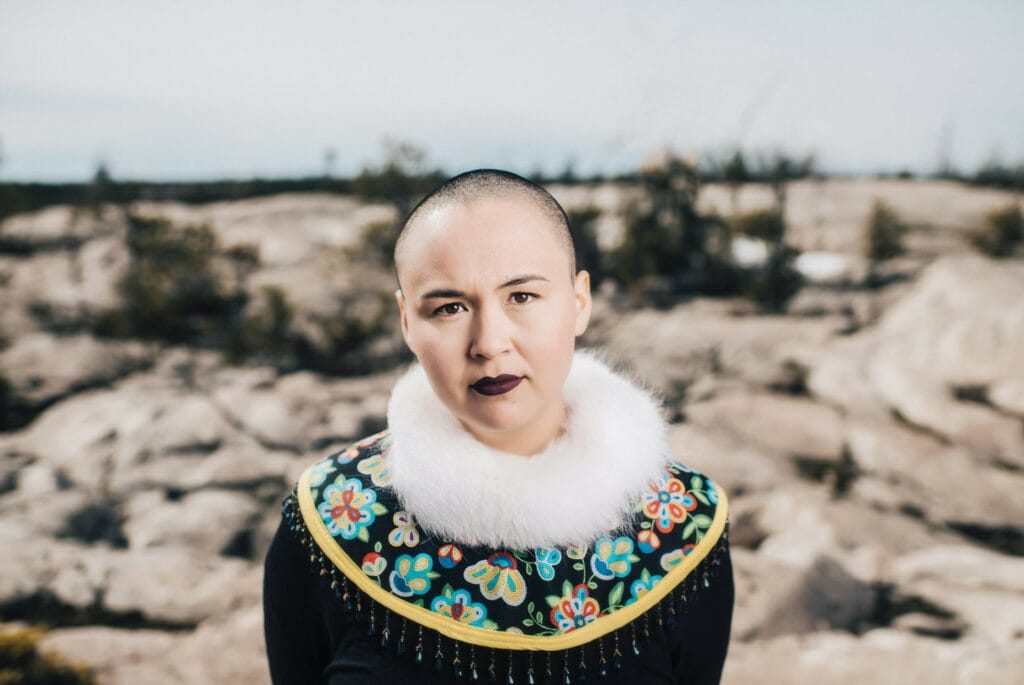A black microphone captured deep, echoing sounds. Seated next to a glass cabinet filled with stone sculptures, animal skulls and milky white ivory, I throat sang. On the wooden floors a blue loop pedal layered sounds, orchestrating a song. A rhythmic melody of what lingers in my mind. Sounds that have travelled through new lands and passing generations. An audience stood by watching silently. With each rise and progression, I went deeper into the sound. Heat rising through my gut, waves washing throughout my body.
Finally, after years of holding back in fear, I found peace through song. Completely inundated with pleasure, power and surviving history.
Ironically, growing up in Rankin Inlet, Nunavut, I wasn’t exposed to traditional throat singing. My Inuk mother and Scottish father played country and rock ‘n roll. Garth Brooks, Bryan Adams, Bob Seger, The Eagles, AC/DC and Meatloaf. That was my introduction to music.
As a child my parents had an elaborate entertainment system in our living room with surround sound. Music was always on and vibrations permeated throughout the house. Floors hummed, walls buzzed and sometimes things fell off the shelf. Mom and Dad played feel-good music that invigorated my body and mind, realigning my spirit.
As a ’90s baby, I watched a lot of YTV and the Family Channel. Embarrassingly so, I listened to the Spice Girls, Backstreet Boys, Ja Rule and Britney Spears. In middle school I discovered MuchMusic. It was a step up in musical maturity, though not in some ways, when I started listening to Blink 182, Linkin Park and Sum 41. By high school I was fully consumed with teenage angst and bled my ears to Alexisonfire, Evanescence, Three Days Grace and Billy Talent.
At 18 I learned about katajjaq, Inuit throat singing. I was welcomed into an Inuit family and was expecting the arrival of a little boy, Agalukti-Ipkarnaak. My mother-in-law demonstrated a traditional song called Qirmiguluapik, the Pitiful Little Dog. Originally, throat singing was performed between two women as a form of entertainment. Qirmiguluapik is an old song that has continued thriving today. In short, it’s about a young mush dog struggling to keep up with the rest of the pack. A young girl standing at the back of the qamutiq, sled, encouraged his spirit by singing to him. Eventually he grows and becomes the leader of the pack.
Throat singing with my mother-in-law for the first time was awkward. Like a young, pubescent teenager struggling with confusion and insecurity, I didn’t like it. My idea of music and singing was pop culture and old time rock ‘n roll. But being pregnant with an Inuk baby played a huge role in revitalizing the relationship with my culture. As a vegetarian, I was ravenous for meat. Caribou, bison, seal, beef, moose, narwhal, arctic char, bacon. Over time throat singing came back like a forgotten memory. We practiced at home, walking down the street, on the trail, in parking lots, museums and bathrooms with good echo. Baby wiggled around when we practiced.
On June 22, 2010 we were scheduled to perform for Aboriginal Day at the Yellowknife River. June 23rd was my son’s due date. I sat anxiously as we drove out onto the highway. I was still garnering the confidence to throat sing in front of people. As we waited behind stage, I felt a warm gush of liquid trickling down my legs. I looked down.
“I think my water broke…” I said discreetly.
“Oh my god, Ingutaq (grandchild) – you couldn’t wait twenty minutes before trying to come out or did you want to join the show?” my mother-in-law teased, kneeling down, speaking to my belly.
I debated staying twenty more minutes or going to the hospital. Contractions don’t happen immediately after the water breaks like in the movies.
“You should go. The water’s going to keep spilling – we don’t want that on stage. I’ll come see you when I’m done.”
At the hospital I walked up and down the hallways waiting for the contractions. They came in waves, soft and strong. Soon it became too difficult to stand. Agalukti’s dad held my hand as I hummed and ahh’ed through the pain. He smiled, eyes glittered with tears. Baby, a manifestation of love, on his way.
Mother-in-law arrived, threw her purse on the chair and jumped in. Rubbing my tailbone in circular motions, she hummed along with me. We sang and breathed together with each ebb and flow of pain. We hummed together as the pain mounted higher and higher until it was time to push. Standing beside the hospital bed she said quietly, “You’re throat singing the baby out.”







